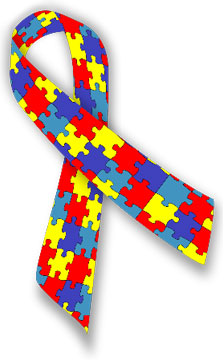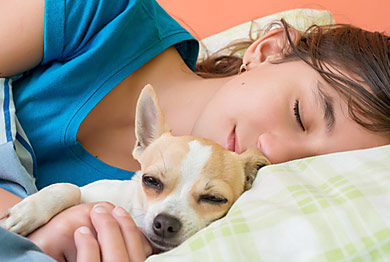 Children with autism may be faced with multiple challenges including problems with socialization, behavior, and learning. A common problem among children with autism is an inability to achieve restful sleep. Sleep problems are prevalent in the autistic population and can be a common complaint voiced by parents.
Children with autism may be faced with multiple challenges including problems with socialization, behavior, and learning. A common problem among children with autism is an inability to achieve restful sleep. Sleep problems are prevalent in the autistic population and can be a common complaint voiced by parents.
We know that sleep deprivation has a detrimental effect on children and their families. Problems sleeping have been linked to behavior problems in children as well as symptoms of attention -deficit/hyperactivity (ADHD). Poor sleep makes it difficult to concentrate in school and to perform executive functioning activities such as the ability to organize and plan. When children are not well-rested, they can have increased problems with other chronic conditions such as epilepsy, asthma, and diabetes. In addition, poor sleep has been associated with an increased risk of obesity.
Sleep problems in children can include a variety of problems with breathing, movement of arms and legs, inability to fall asleep and stay asleep, and sleep-related behaviors such as sleep walking, sleep talking, and teeth grinding. A difficult night of sleep makes it difficult for a child to achieve their maximum potential the next day. Sleep problems in children with autism may be especially severe and may require the help of a team of specialists dedicated to helping the child, and family, sleep better.
 Approximately 70% of children with autism have problems sleeping. Outside factors in the world of the child with autism that may influence his or her inability to sleep include sensory sensitivities and disruptions in routine. Internal factors may include anxiety, an inability to settle down for the night, difficulty reading social cues, and an inability to regulate emotions. Physical factors in children with autism that may interfere with sleep include differences in the production and regulation of sleep hormones and sleep neurotransmitters (chemical messengers that help to transmit signals in the brain).
Approximately 70% of children with autism have problems sleeping. Outside factors in the world of the child with autism that may influence his or her inability to sleep include sensory sensitivities and disruptions in routine. Internal factors may include anxiety, an inability to settle down for the night, difficulty reading social cues, and an inability to regulate emotions. Physical factors in children with autism that may interfere with sleep include differences in the production and regulation of sleep hormones and sleep neurotransmitters (chemical messengers that help to transmit signals in the brain).
- Are sleep problems common in children with autism? Yes
- Is it OK for children to have poor sleep because they have autism? No
- Is there anything that can be done to help children with autism to sleep better? Yes
The first step to getting children with autism to sleep better is to ask the question, “How is the child with autism sleeping?” Do they have difficulty falling asleep, staying asleep, or both? Are there symptoms of potential physical problems including snoring, pauses in breathing during sleep, restless sleep, sleeping in unusual positions, or kicking legs in sleep? If there is the potential for a physical problem related to sleep, the child should be evaluated by their primary care provider or a sleep specialist with consideration toward obtaining a sleep study.
Children with autism are children first. They have some of the same problems as unaffected children. Attention should be given to obtaining control of any underlying chronic conditions such as asthma, GE reflux, and diabetes. While sleep problems can make chronic conditions worse, chronic conditions can also make it difficult for the child to sleep well.
Sensory issues can affect the ability of the child with autism to settle down for the night. Bright lights, noises, textures of bed clothes and linens can all make it difficult for children to relax. Children with autism are often crave routine and have difficulty making transitions. The bedtime routine is critical. All sleep training strategies stress routine, routine, routine, and consistency, consistency, consistency. The bedtime routine should start approximately 1-2 hours before bed and proceed as close to the same way each night. This also helps the child learn the social cues associated with getting ready for bed: decreasing household activity, dimming house lights, taking a bath, brushing teeth, etc. If things are done in the same order, at the same time every night, the child will more likely realize that bed time is soon to follow.
 Many children with autism use tablets, computers, and other electronic devices to self-soothe. Children may use these devices for multiple hours during the day and into the night. The use of electronics during the evening and night hours can interfere with sleep in a number of ways. First of all, if they are being used at night, the child is not giving their body the opportunity to go to sleep. Second, the light from electronic devices has been shown to interfere with the release of sleep hormones in the brain such as melatonin. Eliminating or limiting electronic devices in the evening and night for children with autism can be challenging. If decreasing screen time is an impossibility, efforts can be made to dim the screen light or the child can be encouraged to use special glasses that block blue light – the type of light that can interfere with sleep.
Many children with autism use tablets, computers, and other electronic devices to self-soothe. Children may use these devices for multiple hours during the day and into the night. The use of electronics during the evening and night hours can interfere with sleep in a number of ways. First of all, if they are being used at night, the child is not giving their body the opportunity to go to sleep. Second, the light from electronic devices has been shown to interfere with the release of sleep hormones in the brain such as melatonin. Eliminating or limiting electronic devices in the evening and night for children with autism can be challenging. If decreasing screen time is an impossibility, efforts can be made to dim the screen light or the child can be encouraged to use special glasses that block blue light – the type of light that can interfere with sleep.
Children who are restless at night may benefit from weighted blankets or Lycra sheets to help them to settle down at night. If there are no sensitivities, white noise such as a fan or looping music may be helpful. Children without sensitivities to touch may benefit from a light massage or vibration to help them to settle down before bed.
Finally, there is the question about whether children with autism should be medicated for sleep. Medication should always be considered carefully, and should be only considered after examination of sleep hygiene and sleep training practices. In some instances, children with anxiety and hyperactivity that cannot be otherwise controlled may benefit from medication to help them to settle down for the night. In addition, differences in the production of sleep hormones and neurotransmitters in children with autism may require the need for sleep medications to help to address those conditions. Parents should discuss the need for sleep medications with their child’s medical provider.
Sleeping problems in children with autism can be due to multiple factors. However, it is not appropriate to assume that just because a child has autism that they should be unable to sleep. There are treatment methods that can be used to help children with autism to achieve restful, restorative sleep. Sleep should be an achievable goal for all children with autism and their families.


 My dog snores. People don’t often think about pets as a potential source of sleep disturbance. I will never forget a patient that I had several years ago that had headaches and problems sleeping. I asked all of the typical questions about her sleep hygiene and habits but nothing stood out, until my patient volunteered, “I think it’s my pig”. I looked up from my computer and asked her to repeat what she had said. She said again, “I think it’s my pig”. She then proceeded to take out her cell phone and show me a picture of her pet potbelly pig. My patient’s pig wasn’t exactly Wilbur-sized, but was almost as big as she was! It turns out that the pig slept in the bed with her and the pig kept her up all night by kicking her in his sleep. My patient’s pig had periodic limb movements! My solution for her sleep problems: remove the pig from her bed!
My dog snores. People don’t often think about pets as a potential source of sleep disturbance. I will never forget a patient that I had several years ago that had headaches and problems sleeping. I asked all of the typical questions about her sleep hygiene and habits but nothing stood out, until my patient volunteered, “I think it’s my pig”. I looked up from my computer and asked her to repeat what she had said. She said again, “I think it’s my pig”. She then proceeded to take out her cell phone and show me a picture of her pet potbelly pig. My patient’s pig wasn’t exactly Wilbur-sized, but was almost as big as she was! It turns out that the pig slept in the bed with her and the pig kept her up all night by kicking her in his sleep. My patient’s pig had periodic limb movements! My solution for her sleep problems: remove the pig from her bed!